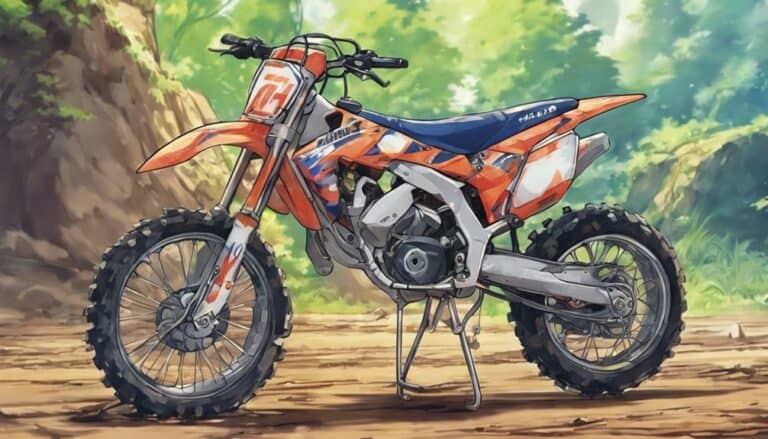Imagine a puzzle waiting to be solved, the mystery behind why dirt bikes sport smaller rear wheels beckons your attention.
With a design as intriguing as it is functional, these smaller rear wheels hold a key role in enhancing a dirt bike's performance.
Stay tuned to unravel the intricate reasons behind this engineering choice and discover how it influences the way dirt bikes handle different terrains and riding conditions.
Key Takeaways
- Smaller rear wheels reduce weight for easier handling and swift maneuvering.
- Enhanced traction, stability, and grip due to a larger contact patch with the ground.
- Improved acceleration capabilities and power transfer from the engine.
- Better control and balance during rides, especially on diverse terrains.
Traction and Acceleration Benefits
Smaller rear wheels on dirt bikes offer enhanced traction and acceleration benefits due to their wider tires and reduced rotational mass, optimizing grip on varied surfaces and improving acceleration performance.
The wider tires create a larger contact patch with the ground, increasing traction and providing better grip on loose or slippery terrains. This improved grip translates to more efficient power transfer from the engine to the ground, resulting in faster acceleration capabilities.
Additionally, the reduced rotational mass of the smaller rear wheels requires less energy to get the bike moving, enhancing acceleration further.
Braking Performance Advantage
Enhancing braking performance on dirt bikes, the reduced rotational mass of the smaller rear wheels improves stopping power and control, providing riders with increased safety and precision during deceleration maneuvers. The smaller wheels contribute to quicker response times, allowing riders to modulate their braking more precisely for the best control. The wider rear tires on these smaller wheels create a larger contact patch with the ground, enhancing braking efficiency across various terrains. Additionally, the weight reduction from using smaller rear wheels enables riders to have more precise modulation over the braking force applied, resulting in improved control over the bike's deceleration. Overall, the combination of reduced rotational mass, quicker response, larger contact patch, and weight reduction in dirt bikes' smaller rear wheels offers riders a significant advantage in braking performance, important for maintaining safety and control in challenging off-road conditions.
| Aspect | Impact | Benefit |
|---|---|---|
| Rotational Mass | Reduced inertia | Quicker response |
| Contact Patch | Increased surface area | Improved efficiency |
| Weight Reduction | Enhanced modulation capabilities | Precise control |
Weight and Maneuverability Considerations
Considering weight and maneuverability factors in dirt bike design involves optimizing components for enhanced control and agility across diverse terrain types. Smaller rear wheels play a vital role in achieving these objectives. By reducing the weight of the rear wheel, dirt bikes become easier to handle, especially in challenging terrains and tight areas.
The decreased rotational mass from smaller rear wheels greatly improves the bike's responsiveness and overall handling, allowing riders to maneuver swiftly through obstacles with greater ease. Additionally, the compact size of the rear wheels enhances the bike's balance and control during high-speed rides, contributing to a more stable and controlled riding experience.
This reduction in weight not only aids in acceleration but also ensures that the bike maintains its agility and maneuverability, making it a preferred choice for riders seeking the best performance and control on varying surfaces.
Front Wheel Size and Handling
Reducing the weight of the rear wheel in dirt bike design greatly impacts handling and agility. Now focusing on the front wheel size and its influence on overall bike performance over rough terrains.
Larger front wheels on dirt bikes play a critical role in providing better stability and control when moving through challenging off-road conditions. The increased size of the front wheel enhances the bike's ability to absorb bumps and shocks effectively, contributing to a smoother ride over rough terrain. Additionally, narrower front tires aid in shock absorption, improving the bike's handling over obstacles by allowing the tire to conform better to the terrain.
Moreover, the diameter of the front wheel directly impacts steering leverage and precision in maneuvering the bike through various obstacles. The best front wheel size not only enhances handling performance but also reduces stress on the bike, ensuring a more controlled and stable ride over rough terrains. Selecting the right front wheel size is essential for achieving superior handling and control while riding dirt bikes in challenging environments.
Tire Sizes and Trail Bikes
Tire sizes on trail bikes greatly impact overall performance and handling characteristics in off-road conditions.
The front wheel of a dirt bike usually boasts a larger diameter, typically 20 to 21 inches, compared to the rear tire's 18 to 19 inches. The larger front wheels aid in shock absorption, enhancing handling capabilities by effectively absorbing bumps and shocks. Additionally, the narrower front tires contribute to improved shock absorption and ease of maneuvering obstacles, ultimately leading to better handling on trails.
The balance between front and rear tire sizes is critical for optimizing suspension travel and handling performance across various terrains. Smaller rear tires with diameters of 18 to 19 inches are specifically designed to offer better traction, stability, and control in off-road conditions. This combination of larger front wheels and smaller rear tires creates a larger contact patch for improved grip, while the gyroscopic effect of the wider front wheel enhances stability and enables better braking performance on rugged trails.
Conclusion
To summarize, dirt bikes feature smaller rear wheels for enhanced traction, faster acceleration, and improved handling dynamics.
The saying 'small but mighty' perfectly encapsulates the performance benefits of these compact wheels.
By reducing rotational mass and overall weight, dirt bikes equipped with smaller rear wheels are able to conquer challenging terrain with agility and speed.
So next time you hit the trails, remember that big things can come in small packages when it comes to dirt bike rear wheels.

